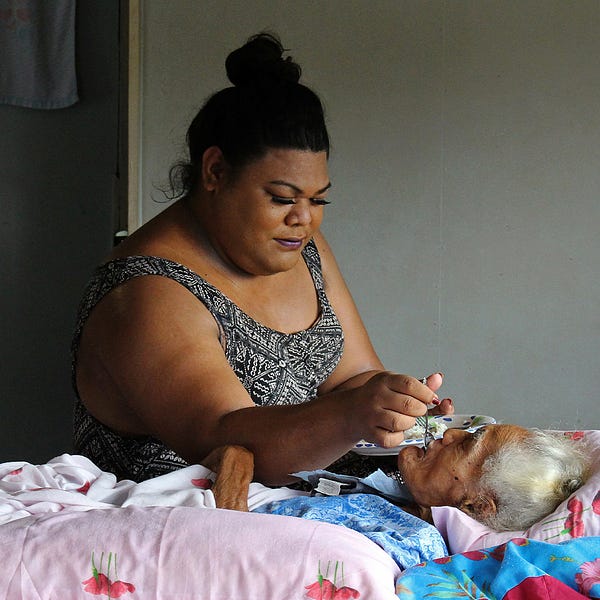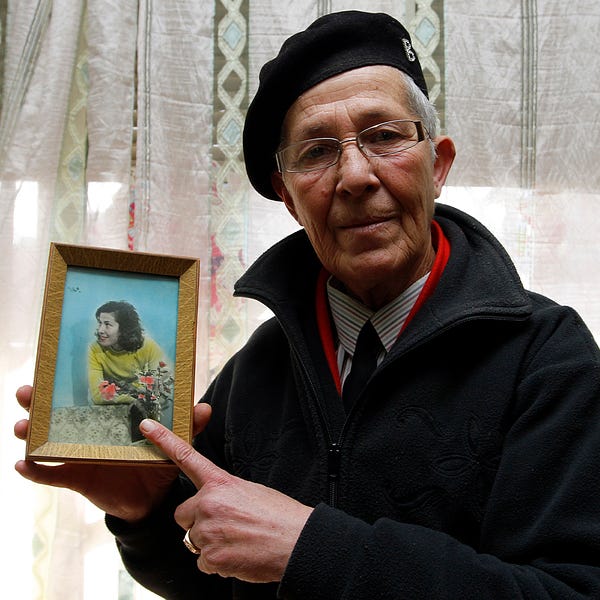What Is The Goal Of Our Great Big Gender Conversation? (Unlocked)
Or: Why an LGBT outlet enthusiastically supported grossly homophobic, patriarchal cultures (for social justice)
My subscribers voted, overwhelmingly, that they are okay with me sometimes unlocking previously paywalled posts that are at least three months old. That’s what I’m doing here — this post ran on 4/16/2021, and the original version lives here. As always, I’m cloning it to protect the privacy of subscribers who commented on the original — this version was created on 7/21/2021 and backdated to reflect the article’s original publication date.
If you find this article useful or interesting, please, please consider becoming a paid subscriber. My paid subscribers are the reason I was able to write this piece in the first place, and they’re the ones who keep this newsletter going.
I’ve previously admitted to some confusion about our big, national conversation about gender. Some parts of it I do get. There’s definitely a level of baseline agreement that is, by historical standards, novel and important: It seems people feel stronger than ever before that no one should be forced to adopt gender roles that feel wrong to them, that gender nonconforming children shouldn’t be punished for ‘girly’ or ‘tomboyish’ behavior, and that in many ways the socially constructed gender categories of ‘man’ and ‘woman’ are imposed on people in ways that cause harm. Moreover, there is widespread and growing agreement, at least on the left, that people should have access to hormones and surgery to treat gender dysphoria. (Let’s leave the subject of youth medical transition, which is far more complicated, to the side — just this once [I’m begging you].)
But beyond those areas of general consensus, there’s a fair bit of confusion and contention, even on the left. If the strongest claim being made were “Young boys shouldn’t be punished for wanting to have long hair and to play with dolls,” there’d be effectively no left-of-center disagreement on this subject. Instead, some stronger and more provocative claims about the nature of subjective experience, identity, and the link between the two have not only caught on, but are increasingly seen as prerequisites to being a decent human. These are claims that spark dispute in a way the statement “We should love little girls who are tomboys as much as we love ‘little princesses’” does not.
I’ve found much of this conversation to be really aphilosophical, if that’s the word. Contemporary gender discourse isn’t really undergirded by any strong, stable sense of what we’re trying to determine, or what values we hold, or what shared realities we can agree on, or where there might be (gasp!) conflicts or tradeoffs inherent to some given instance of ideological/metaphysical zigging rather than zagging, or zagging rather than zigging, on certain questions.
I was reminded of this last week when an outlet called Openly published a tweetstorm that starts here:

This was seen as a sufficiently big, important debunking of those darn “gender binaries” that Twitter itself helped to promote the thread.
Let’s focus on a couple entries in particular. Like this one:


And this one:


These examples are, uh, interesting.
Starting with the fa’afafines, let me just borrow from myself:
In Samoa, for example, there has long been a third gender known as fa’afafine, or what we would view in our society as ‘girly’ biological males. Traditionally, there were two ways for a biological male to be slotted into this identity: Sometimes, it would simply be determined, at a young age, that a boy was really a fa’afafine because of his effeminate behavior, at which point they would be raised as not quite a boy and not quite a girl, but as a girly boy able to take part in stereotypically effeminate tasks and behaviors without judgement. As one fa’afafine told the Australian Broadcasting Corporation, “When I was young, my parents looked at me and the way I am...and they think, Oh Hazy, she must not be a boy, but something else. And then, they never accuse me… they really accept me. They understand what I am, in my body.” In other instances, explains the ABC, “In families of all male children (or where the only daughter was too young to assist with the ‘women’s’ work), parents would often choose one or more of their sons to help the mother. Because these boys would perform tasks that were strictly the work of women they were raised as if they were female. Although their true gender was widely known, they would usually be dressed as girls.” (This must be an interesting experience for boys with no strong interest in feminine activities or identity, but Johanna Schmidt, an expert on the fa’afafine at the University of Waikato in New Zealand, told me this occurs less frequently than media accounts would indicate.)
While Hazy had a good experience in this role, that isn’t true for everyone, as SBS News reported:
Some Polynesian elders believe there are boys born with the “Fa'afafine spirit,” while others say it can be nurtured.
Boys like Leo Tanoi, who don't feel the Fa'afafine spirit, may be nominated as the Fafa in a family of all boys but Leo says that doesn't always work out for the best.
“Quite a lot of the memories I have related to this is all the physical abuse,” he says.
“A lot of physical violence, a lot of pulling my pants down, tying me up, beating me up in front of everybody. That sort of behaviour. I got used to being told in front of people that I'm a girl. It was a very lonely time and I don't think people know how lonely it was.”
The abuse did not come from Leo's mother but from his six brothers and a lynch mob of boys in his community who wanted to toughen him up to bring him back to “manhood”.
That pressure, compounded by his mother's encouragement toward femininity, caused much confusion.
Now let’s look at those sworn virgins in Albania, as described in a 2008 New York Times article:
KRUJE, Albania — Pashe Keqi recalls the day nearly sixty years ago when she decided to become a man. She chopped off her long black curls, traded in her dress for her father's baggy trousers, armed herself with a hunting rifle and vowed to forsake marriage, children and sex.
Had she been born in Albania today, says the 78-year-old sworn virgin, who made an oath of celibacy in return for the right to live and rule her family as a man, she would choose womanhood.
[...]
The sworn virgin was born of social necessity in an agrarian region plagued by war and death. If the patriarch of the family died with no male heirs, unmarried women in the family could find themselves alone and powerless. By taking an oath of virginity, women could take on the role of men as head of the family, carry a weapon, own property and move freely.
They dress like men, adopt a male swagger and spend their lives in the company of other men.
Some also took the vow as a means to avoid an arranged marriage. Still others became sworn virgins to express their autonomy. Some who regretted the sacrifice transformed themselves back into women and married later in life.
Would anyone choose either of these systems over the progressive understanding of sex and gender? I don’t think so. It feels like in both cases these gender categories were introduced because societies with much more conservative views on gender than ours couldn’t otherwise handle the idea of a ‘girly’ boy still being a boy, or of a woman inheriting her father’s or husband’s property.
And an LGBT outlet, with an assist from Twitter itself, seems to be celebrating this! If they aren’t celebrating this, what point are they making by providing these as examples of how “The gender binaries of ‘male’ and ‘female’ aren’t as universal as you think”? The goal of the tweetstorm certainly isn’t to get people to say, “Huh, those systems seem backward.” It was a celebratory thread, not a burn thread.
That sentence about the binaries is technically true, I guess, but not in the way Openly wants it to be. “The gender binaries of ‘male’ and ‘female’ aren’t as universal as you think” in part because there are some cultures with such rigid views of them that if you deviate from them, or if you want to enjoy a privilege only granted to men despite not being one, you’re routed into a whole other category.
This is what I mean about this conversation lacking any sort of grounding. We really can argue for this or that understanding of gender, for two main categories or three or 100 or a billion. But that requires actually discussing what our values are, what we want gender to mean, and what (again, GASP) the tradeoffs of adopting one view versus another might be. For example, while you can’t really pluck a given practice out of its cultural context, there are clearly some downsides to the way this whole fa’afafine thing works. Some kids are forced to adopt a gender role that might not fit just because the culture isn’t comfortable with males doing ‘women’s’ work! That seems bad…
Similarly, if this conversation were less heated and better grounded, one could argue — and one perhaps wouldn’t feel skittish enough to have to put this argument behind a paywall (update: whoops) — that there are potential downsides to a third-gender system like the one evolving in the States, where a youth “not feeling like a boy or a girl” is sometimes enough for adults to instantly say, “Ah, okay — so you’re clearly not a boy or a girl.” For example, there’s a chance — JUST A CHANCE DON’T HURT ME — that if it becomes solidified this norm could actually point us in a fa’afafinian direction, where when we look at a young girl with a preference for short hair and rough-and-tumble play, we say, Ah, they must be nonbinary. One could argue — JUST ‘ARGUE’ NOT “STATE DEFINITIVELY” DON’T HURT ME — that the burgeoning tendency to instantly reify the sentiment “I don’t feel like a boy or a girl,” to treat it as automatically meaning that someone occupies a third gender category, might have some downsides. Another approach would be to treat a statement like this with compassionate inquisitiveness: “What do you mean by that? What does it mean to feel like neither a boy nor a girl?” Perhaps sometimes that will lead to the realization that yes, a nonbinary identity is best, but other times it will lead elsewhere. (This is all what competent youth gender clinicians do anyway.)
Again, I’m just talking about potential tradeoffs. Which is how you have a real discussion. I can’t claim to know where any of this is going or what is best or whether it’s in some sense better or healthier for a gender nonconforming 12-year-old to view coming out as nonbinary as a viable option than it is for them to feel they have to be a boy or girl.
I’m just a nerd! And a noodge. I want this discussion to mean something. Instead, it’s so driven by random outrage and various strains of fundamentalist thinking that we’ve reached a point where, well, an LGBT magazine is lauding deeply patriarchal, homophobic cultures for their supposed wokeness. Something is amiss here.
Questions? Comments? Suggestions for a gender that would fit me better than ‘man,’ which clearly hasn’t worked out so far? I’m at singalminded@gmail.com or on Twitter at @jessesingal. The photo of someone holding a “Hello/My Pronouns Are…” was taken by Sharon McCutcheon and comes via Unsplash.

